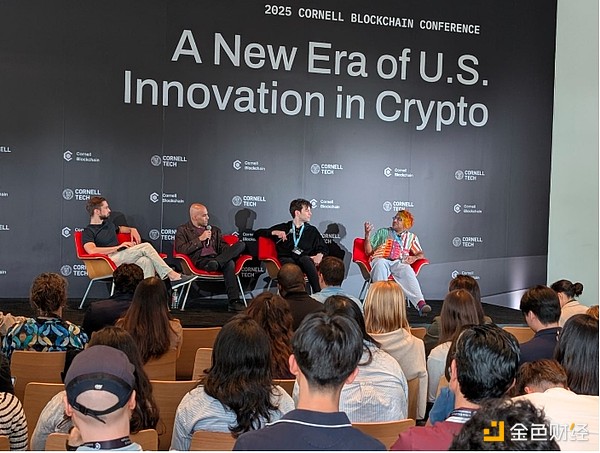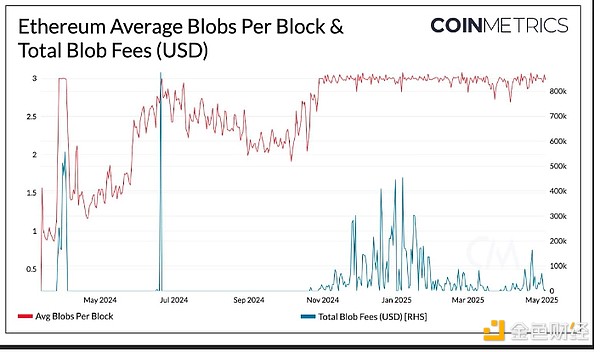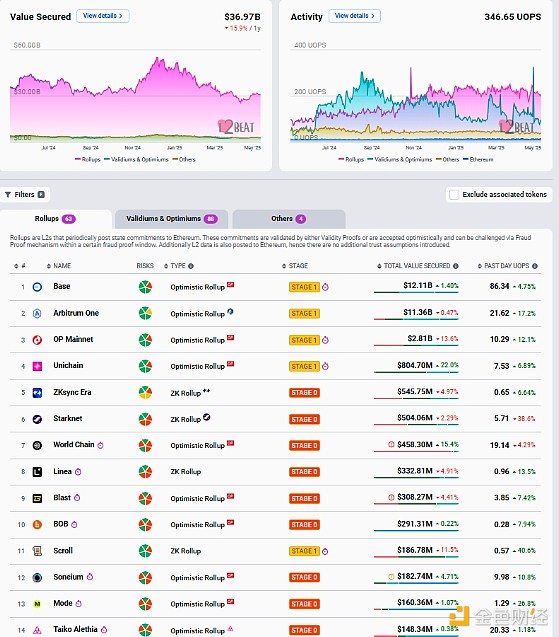Author: Andrew Singer, CoinTelegraph; Compiler: Baishui, Golden Finance
Layer 2 has been the great success story in the blockchain space. They relieved congestion on the Ethereum mainnet, lowered gas fees, and guaranteed security.
But perhaps they were so successful that they siphoned off a lot of on-chain activity and fee revenue from the parent chain that gave birth to them? At least that’s what some people think recently, most recently at the Cornell Tech Blockchain Conference in late April.
In fact, some people think Ethereum should be greedier, or at least should work harder to get a bigger share of the revenue, especially sorting fees.
“People at the Ethereum Foundation (the nonprofit that supports the Ethereum ecosystem) will tell you, ‘Yeah, we screwed up because we were too ivory tower.’ I’ve heard this a lot of times,” said David Hoffman, the boss of Bankless, during a panel discussion at a Cornell Tech event in New York on April 25.

Hoffman (left) attends the Cornell Tech Blockchain Conference. Image credit: Andrew Singer
In addition, Hoffman urged Ethereum to make a "strategic transformation", noting that the crypto environment has changed in the past few years. Ethereum no longer has the "luxury of research projects... being exploited by competitors."
James Beck, head of growth at ENS Labs and another speaker at the New York conference, said L2 is collecting millions of dollars in transaction order fees (sometimes called sorting fees), but that revenue is not being transferred to Ethereum. “Well, the price of ETH has been falling compared to other tokens,” Baker noted. “What can we do to make Ethereum stronger?”
In short, Ethereum is a neutral validation layer, but the Ethereum mainnet is not being fairly compensated for the work it does. Centralized for-profit L2s like Base, Optimism, and Arbitrum are collecting lucrative ordering fees while enjoying the security and liveness guarantees of the Ethereum mainnet at a relatively low economic cost.
L2 Transaction Volume Soars After Dencun Upgrade
L2 Rollup is a recent innovation that only appeared in 2023. Its original intention was to reduce blockchain congestion and gas fees by moving transaction processing from the main blockchain (Layer 1) to a separate chain (L2) that sits on top of the mainnet. But transaction processing is undoubtedly the most profitable part of the revenue distribution, especially if users choose to pay priority fees to speed up order processing.
Prior to Ethereum's Dencun upgrade in March 2024, fee sharing was hardly a big deal. The Dencun upgrade introduced blob transactions to help scale Layer 2. CoinMetrics researcher Tanay Ved noted this week that blob transactions significantly reduce the cost of L2 sending data to Ethereum, allowing it to operate more efficiently.
Since then, L2 user demand has soared, especially on Base transactions, which Coinbase launched on the Ethereum mainnet in August 2023.
As Ved noted in an April 8 blog post, Base has earned a total of approximately $98 million in revenue from user transaction fees (including base fees and priority fees), "while only paying approximately $4.9 million to the Ethereum base layer, so Base's total profit since the Dencun upgrade is estimated to be $94 million."
Ved added: This dynamic has led many to question whether Layer-2 is a net positive for Ethereum or "extractive."
Base’s Response
When asked about fees, a Base spokesperson said: “Today, Base already pays Ethereum fees for every transaction on the platform. All transactions are settled on Ethereum, and Base has paid over $20 million in settlement fees to Ethereum since its inception.” The spokesperson added that you can view these fees under “Cost of Revenue” in Token Terminal.
“Overall, Base makes it easier to get on-chain through fast and cheap transactions, and helps grow the Ethereum ecosystem by onboarding more users, developers, applications, and assets, all of whom are using ETH to transact and driving demand,” the spokesperson said.
However, according to the Base financial statements cited, in many months, if not most months, Base’s total fees are roughly 10 times the transaction settlement fees paid to Ethereum. For example, in April, the most recent full month, Base earned $3.7 million in fees, but only $305,000 was paid to Ethereum as settlement fees, or about 8% of total fees.
Things may not be so bad, though. Others warn that even if fees are imbalanced now, the imbalance may not last. Ethereum hard forks, such as Pectra, which went live yesterday (May 7), and Fusaka, scheduled to go live by the end of 2025, will increase blob throughput. "This means that L2 will be able to issue more blobs, which could drive up the total blob fees on the mainnet," Ved noted.
As shown in the chart below, Ethereum has steadily achieved its current goal of three blobs per block. Ved added: “Pectra will increase this number to 6 blobs per block, up to 9, creating room for fee increases as L2 activity expands.”

Average number of blobs per block on Ethereum and their total blob fees (in USD). Source: CoinMetrics
Is a “rollup-based” solution the answer?
Some Ethereum researchers, podcasters, and even L2 chain developers favor “rollup-based” as a more permanent solution to the fee problem and provide better security. In this case, transaction ordering (i.e., sorting) would be done on the mainnet, not on the L2 chain.
Some researchers say that the sorters used by Optimism, Arbitrum One, Base, and others are more vulnerable to attacks or failures because they are centralized and have a single point of failure.
If a centralized sorter fails, the rollup effectively stops working entirely, writes Polygon’s Jarrod Ward. It stops processing transactions from users on the L2 chain, and it stops sending batches of data back to Ethereum.
“Layer-2 sorters have become very centralized and very dangerous,” added Tom Ngo, executive lead of Metis, an Ethereum Layer-2 blockchain.
Last June, Ethereum's second-layer blockchain Linea was hacked and lost $2.6 million, which made Ngo and others deeply aware of the importance of decentralization and the dangers of centralized sequencers.
Last year, several L2 projects based on rollups were launched. Taiko Alethia was the first and largest project, which was launched in May 2024. A year later, its total guaranteed value reached $148.3 million, ranking 14th on L2Beat's L2 project list, but far below the leader Base's $12.06 billion.

Ethereum Layer 2 tokens ranked by total guaranteed value. Source: L2Beat
In terms of speed, Taiko’s average user operations per second (UOPS) on May 7 reached a respectable 20.3, which is far behind Base’s 86.3 UOPS, but comparable to Arbitrum One’s 21.6 UOPS, and significantly better than Optimism’s 10.3 UOPS.
Tax on L2?
Another idea in the Ethereum community is to tax L2. But Ved said that doing so could have some unintended consequences. It could make L2 less competitive. It could also lead to "activity leaking to competing Layer 1s outside the Ethereum ecosystem." Ved said that activity currently flowing to Base could flow to Solana or other Layer 1s.
There could also be some philosophical issues if Ethereum taxes its L2. Ved noted:
Taxation could run counter to Ethereum's decentralized philosophy, which favors market-driven rather than forced taxation.
In general, Ved explained, the Ethereum Foundation seems to prioritize long-term growth over short-term revenue. However, proposals like EIP-7762, which could bring more fee revenue to the Ethereum mainnet by raising the minimum blob base fee and speeding up price discovery when demand surges, could have a tax-like effect.
Social pressure?
According to ENS Labs’ Beck, it may take some social pressure for the leading centralized layer-2 to voluntarily give up its ordering fees. Other layer-2s like Linea may need to step in and make a statement to the centralized layer-2s like, “Look, these risks exist in more centralized designs, and now it’s time to build [order processing] into the more decentralized Ethereum.”
To this end, ENS participated in a three-day workshop in the UK in January, which included top researchers and developers from entities such as Linea, Status, OpenZeppelin, Titan, Spire Labs, and the Ethereum Foundation. The top priority was how to create scalable decentralized infrastructure for ENS Labs’ Namechain and how to bring together teams from across the Ethereum ecosystem to solve the interoperability challenges of layer-1s and rollups.
Beck acknowledged that getting work done in a flat (non-hierarchical), multi-party entity like Ethereum is not easy. “Ethereum is a decentralized ecosystem. You can’t get everybody to agree at the same time.” But collaborations like this recent one in the U.K. are a start.
Hoffman, a panelist at the Cornell Tech conference, expressed confidence that Ethereum can pivot and “turn Layer-1 into Rollup” with processing speeds comparable to today’s Layer-2.
As mentioned above, Hoffman has criticized the Ethereum Foundation for being too closed and academic, but he sees some signs that things may be changing, writing recently:
The appointment of Tomasz Stańczak and Hsiao-Wei Wang as co-executive directors signals a new era of accountability, direction, and internal cohesion.
“I’m optimistic,” Baker added. “Ethereum still has the most locked assets in DeFi; the most stablecoins are on Ethereum. BlackRock has a fund that’s being settled on Ethereum.”
In other words, Ethereum still has the ability to provide the infrastructure for the “network of networks” — the smoothly interacting web of private and public chains that many hope will be the future of the technology.
 Catherine
Catherine







